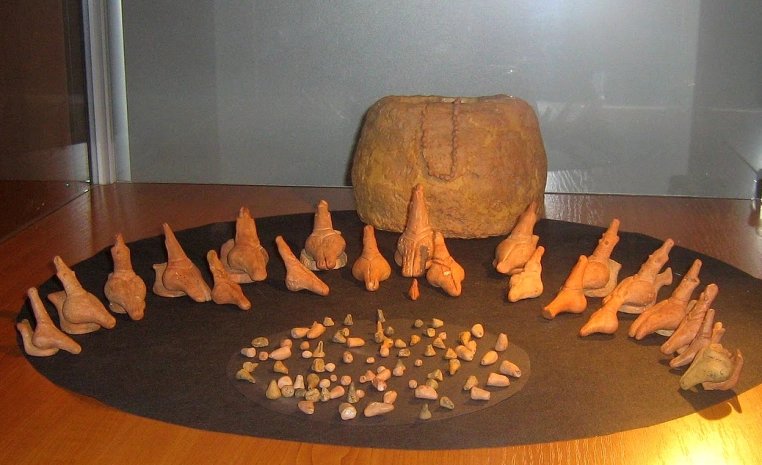Mysterious Cucuteni-Tyrpillian Culture Burned Their Settlements For Unknown Reasons
Ellen Lloyd - AncientPages.com - The mysterious Cucuteni-Trypillian culture lived in Eastern Europe thousands of years ago. They left behind a number of intriguing ancient artifacts, destroyed settlements, and sacred sanctuaries. It remains unclear why and how they vanished. It is also a mystery why they regularly burned their settlements.
These people lived in an area of around 35,000 square kilometers, incorporating parts of present-day Moldova, Romania, and Ukraine, between 5400 and 2700 BCE.
The discovery of the Cucuteni-Trypillian culture
The culture was initially named after the village of Cucuteni in Romania.
In 1884, Teodor T. Burada, after having seen ceramic fragments in the gravel used to maintain the road from Târgu Frumos to Iași, investigated the quarry in Cucuteni from where the material was mined, where he found fragments of pottery and terracotta figurines.
At the same time, in 1893, the first Ukrainian sites ascribed to the culture were discovered by Vicenty Khvoika, who found ancient ruins near the village of Trypillia in the Obukhiv District of central Ukraine's Kiev Oblast.
Prior to the discovery of Trypillia in the late 19th century – a time when great archeological discoveries were taking place in various parts of the world – it seemed that Eastern Europe had made no notable prehistoric contributions to the development of so-called civilization in the region. But all this changed in 1893 as archeologists started to explore the ruins of these ancient settlements and discovered that the Cucuteni-Trypillian culture had established cities to accommodate up to 15,000 inhabitants, being some of the largest settlements in Neolithic European history (7000 BCE-1700BCE)
The Cucuteni-Trypillian Deliberately Burned Their Settlements Regularly
In the middle era, the Cucuteni-Trypillian culture spread over a wide area from Eastern Transylvania in the west to the Dnieper River in the east. During this period, the population immigrated into and settled along the banks of the upper and middle regions of the Right Bank (or western side) of the Dnieper River in present-day Ukraine. The population grew considerably during this time, resulting in settlements being established on plateaus near major rivers and springs.
 Recreation of a Cucuteni-Trypillian house burning. Credit: Arheoinvest - Public Domain
Recreation of a Cucuteni-Trypillian house burning. Credit: Arheoinvest - Public Domain
Archaeologists noticed something strange while investigating the ruins left behind by the Cucuteni-Tyrpillian culture. These ancient people deliberately burned their settlements after some years.
The purpose of the periodic destruction of settlements, with each single-habitation site having a roughly 60 to 80-year lifetime, remains debated among scholars. Some of the settlements were reconstructed several times on top of earlier habitational levels, preserving the older buildings' shape and orientation. One particular location, the Poduri site (Romania), revealed thirteen habitation levels that were constructed on top of each other over many years.
Archaeological Treasures And Sacred Sanctuaries Of The Cucuteni-Trypillian Culture
Archeological treasures recovered from these sites include statuettes of both men and women, weapons and other items made of copper and other metals, intricately patterned earthenware, and clay building materials. The female statuettes have featureless faces, while the males have oval, elongated faces with prominent noses and deep-set eyes. Some of the statuettes are naked while others are clothed, with the styles of clothing changing over the years, and the females wore their hair in different styles.
During excavations, archaeologists found several sacred sanctuaries. Artifacts inside these sanctuaries were intentionally buried in the ground within the structure. These objects are clearly of a religious nature and have provided insights into some of the beliefs, and perhaps some of the rituals and structure, of the members of this society.
Many of these artifacts are clay figurines or statues. It is commonly assumed that many of these artifacts are fetishes or totems, which are believed to be imbued with powers that can help and protect the people who look after them.
The End Of The Cucuteni-Trypillian Culture Remains An Open Question
Why the Cucteni-Trypullian culture vanished remains unknown. Scholars have debated the end of the culture, and there are several theories.
According to archaeologist Marija Gimbutas, the Cucuteni-Trypillian culture ended violently in connection with the territorial expansion of the Kurgan culture. Proponents of the Kurgan Hypothesis hold that a violent clash took place during the Third Wave of Kurgan expansion between 3000-2800 B.C.permanently ending the Cucuteni-Trypillian culture.
J.P. Mallory, an Irish-American archaeologist, is not convinced the Cucteni-Trypullian culture met a violent end. Instead, he points out that archaeological evidence indicates what he termed "a dark age," during which the population sought refuge in every direction except the east. He cites evidence of the refugees having used caves, islands, and hilltops (abandoning in the process 600-700 settlements) to argue for the possibility of a gradual transformation rather than a violent onslaught bringing about cultural extinction.
Reconstruction of the Trypillian city Maydanets c 4000 B.C. The Cucuteni-Trypillian culture built large settlements. Credit: Wikipedia - CC BY-SA 4.0
Another theory regarding the end of the Cucuteni-Trypillian culture emerged based on a climatic change at the end of their culture's existence known as the Blytt-Sernander Sub-Boreal phase. Beginning around 3200 B.C, the earth's climate became colder and drier than it had ever been since the end of the last Ice Age, resulting in the worst drought in the history of Europe since the beginning of agriculture. Since the Cucuteni-Trypillian people consisted mostly of farmers, the culture would have collapsed under these climatic conditions.
Written by Ellen Lloyd – AncientPages.com
Copyright © AncientPages.com All rights reserved. This material may not be published, broadcast, rewritten or redistributed in whole or part without the express written permission of AncientPages.com
Expand for referencesMore From Ancient Pages
-
 Trajan’s Market Was The World’s First Known Shopping Mall
Ancient History Facts | Jul 2, 2016
Trajan’s Market Was The World’s First Known Shopping Mall
Ancient History Facts | Jul 2, 2016 -
 Exceptional Precision And Technical Mastery Of Iberian Archery From 7,000 Years Ago
Archaeology | Dec 27, 2024
Exceptional Precision And Technical Mastery Of Iberian Archery From 7,000 Years Ago
Archaeology | Dec 27, 2024 -
 Antediluvian Artifact Discovered In Egyptian Tomb May Solve The Great Pyramid Mystery?
Featured Stories | May 3, 2018
Antediluvian Artifact Discovered In Egyptian Tomb May Solve The Great Pyramid Mystery?
Featured Stories | May 3, 2018 -
 Gigantic Bird Ziz Is One Of Participants At Messianic Banquet At The End Of Days In Jewish Folklore
Featured Stories | May 8, 2020
Gigantic Bird Ziz Is One Of Participants At Messianic Banquet At The End Of Days In Jewish Folklore
Featured Stories | May 8, 2020 -
 Beautiful Mosaics In 1,300-Year-Old Church Discovered In The Lower Galilee
Archaeology | Aug 29, 2020
Beautiful Mosaics In 1,300-Year-Old Church Discovered In The Lower Galilee
Archaeology | Aug 29, 2020 -
 Has The Mystery Of The 11,000-Year-Old Amazonian Rock Art Been Solved?
Places | Nov 15, 2024
Has The Mystery Of The 11,000-Year-Old Amazonian Rock Art Been Solved?
Places | Nov 15, 2024 -
 Rudra – Mighty Hindu God Of Death, Destruction, Hunting Who Heals Mortal Diseases
Featured Stories | Aug 10, 2021
Rudra – Mighty Hindu God Of Death, Destruction, Hunting Who Heals Mortal Diseases
Featured Stories | Aug 10, 2021 -
 Merovingian Dynasty Of Long Haired Kings
Featured Stories | Jan 18, 2019
Merovingian Dynasty Of Long Haired Kings
Featured Stories | Jan 18, 2019 -
 Aboriginal Art And Knowledge Unlocks Mystery Of Fairy Circles
Archaeology | Apr 5, 2023
Aboriginal Art And Knowledge Unlocks Mystery Of Fairy Circles
Archaeology | Apr 5, 2023 -
 Holmgang – Dangerous Viking Duel Settled Disputes
Ancient History Facts | Mar 10, 2018
Holmgang – Dangerous Viking Duel Settled Disputes
Ancient History Facts | Mar 10, 2018 -
 On This Day In History: Sweden’s Greatest Defeat: Battle Of Kirchholm Was Fought – On Sep 27, 1605
News | Sep 27, 2016
On This Day In History: Sweden’s Greatest Defeat: Battle Of Kirchholm Was Fought – On Sep 27, 1605
News | Sep 27, 2016 -
 Ancient Reptilian-Like Humanoids Hold Secrets Of Mankind’s Origin
Artifacts | Apr 12, 2014
Ancient Reptilian-Like Humanoids Hold Secrets Of Mankind’s Origin
Artifacts | Apr 12, 2014 -
 Face-To-Face Encounter With Young Scottish Soldier Who Lived And Died Over 300 Years Ago
Archaeology | Dec 23, 2017
Face-To-Face Encounter With Young Scottish Soldier Who Lived And Died Over 300 Years Ago
Archaeology | Dec 23, 2017 -
 Were There Gladiators In Roman Britain? An Expert Reviews The Evidence
Featured Stories | Mar 14, 2023
Were There Gladiators In Roman Britain? An Expert Reviews The Evidence
Featured Stories | Mar 14, 2023 -
 The Untold Story Of The Great Sphinx – One Of The Greatest – Part 1
Featured Stories | Aug 9, 2019
The Untold Story Of The Great Sphinx – One Of The Greatest – Part 1
Featured Stories | Aug 9, 2019 -
 Mysterious Ichthys – Ancient Secret Christian Symbol With A Deep Meaning
Ancient Symbols | Mar 6, 2018
Mysterious Ichthys – Ancient Secret Christian Symbol With A Deep Meaning
Ancient Symbols | Mar 6, 2018 -
 Ancient Maya Built Sophisticated Water Filters To Obtain Drinking Water
Archaeology | Oct 23, 2020
Ancient Maya Built Sophisticated Water Filters To Obtain Drinking Water
Archaeology | Oct 23, 2020 -
 Archaeologists Uncover Secrets Of ‘Vallø Borgring’ Viking Age Circular Fortress
Archaeology | Oct 11, 2015
Archaeologists Uncover Secrets Of ‘Vallø Borgring’ Viking Age Circular Fortress
Archaeology | Oct 11, 2015 -
 Magnificent Reconstruction Of Scotland’s Largest Pictish Fort Burghead
Archaeology | Nov 3, 2021
Magnificent Reconstruction Of Scotland’s Largest Pictish Fort Burghead
Archaeology | Nov 3, 2021 -
 What Fossils Reveal About Hybridization Of Early Humans – History Of Humankind Is More Complex Than Previously Thought
Archaeology | Sep 6, 2022
What Fossils Reveal About Hybridization Of Early Humans – History Of Humankind Is More Complex Than Previously Thought
Archaeology | Sep 6, 2022




